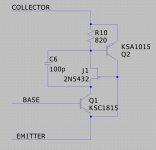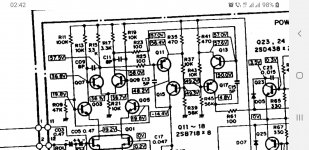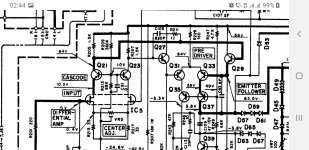On the bench is an Lafayette LR-9090 that I'm doing a little resto mod on to stabilize its power amp and reduce the power amp's distortion performance to >100dB.
Can we upgrade its preamp to the same level of distortion performance?
The -9090 preamp has 3 gain stages. In spice, two of them already perform at the same 100dB-or-better distortion level. Awesome.
The third gain stage is a simple emitter follower buffer that drives the high and low filters; it's in the signal path regardless of whether the filters are engaged. This stage is only good for about -80dB distortion performance. The distortion is caused by a combination of nonlinear Cob, nonlinear Early effect, and nonlinear Vbe variation. It sees an input impedance near 10K ohms, so any input current error caused by the nonlinear Cob or Early effect is multiplied by 10K. That's fairly stiff, but typical for some preamps.
I suspect we could replace an EF stage's transistor with the "transistor equivalent" circuit below to cancel all 3 distortion sources. The beauty of this is it's a 3-terminal circuit -- you could build it on a tiny piece of perf board and it's a "drop in" replacement for the original EF transistor for a minimally invasive, completely reversible mod. Spice shows it reduces distortion in this stage somewhere beyond -110dB.
It's essentially a normal CFP stage, except that Q1 is cascoded by JFET J1. The CFP arrangement ensures Q1 conducts constant current, so its Vbe is constant. The cascode nulls out any Early effect or nonlinear Cob at Q1. C6 is necessary for HF stability.
You could probably extend this with a voltage divider to create a very clean 3-transistor CFA gain stage.
Disclaimers:
1- I haven't built this -- yet. Gotta pick up some JFETs.
2- TBD what JFET to choose for a real build.
3- This circuit requires several volts more headroom at the collector than a single BJT. That's usually not a problem in a vintage preamp with rails in the 18V to 25V range.
4- There's more than one way to compensate this for HF stability. The one shown might not be optimal.
Can we upgrade its preamp to the same level of distortion performance?
The -9090 preamp has 3 gain stages. In spice, two of them already perform at the same 100dB-or-better distortion level. Awesome.
The third gain stage is a simple emitter follower buffer that drives the high and low filters; it's in the signal path regardless of whether the filters are engaged. This stage is only good for about -80dB distortion performance. The distortion is caused by a combination of nonlinear Cob, nonlinear Early effect, and nonlinear Vbe variation. It sees an input impedance near 10K ohms, so any input current error caused by the nonlinear Cob or Early effect is multiplied by 10K. That's fairly stiff, but typical for some preamps.
I suspect we could replace an EF stage's transistor with the "transistor equivalent" circuit below to cancel all 3 distortion sources. The beauty of this is it's a 3-terminal circuit -- you could build it on a tiny piece of perf board and it's a "drop in" replacement for the original EF transistor for a minimally invasive, completely reversible mod. Spice shows it reduces distortion in this stage somewhere beyond -110dB.
It's essentially a normal CFP stage, except that Q1 is cascoded by JFET J1. The CFP arrangement ensures Q1 conducts constant current, so its Vbe is constant. The cascode nulls out any Early effect or nonlinear Cob at Q1. C6 is necessary for HF stability.
You could probably extend this with a voltage divider to create a very clean 3-transistor CFA gain stage.
Disclaimers:
1- I haven't built this -- yet. Gotta pick up some JFETs.
2- TBD what JFET to choose for a real build.
3- This circuit requires several volts more headroom at the collector than a single BJT. That's usually not a problem in a vintage preamp with rails in the 18V to 25V range.
4- There's more than one way to compensate this for HF stability. The one shown might not be optimal.
Attachments
Last edited:
I simulated a bunch of "buffers", and nothing beat a simple complimentary EF. But it had some loss with 22 Ohm emitter resistors, and I was only simulating 1V signals. I will have to try your modified CFP. I see it requires at least 0.8mA, so what was the total that you used? I ran mine at about 5-10mA. And I think I used a 1K load.
Last edited:
This particular EF stage is loaded with a 3.9k resistor to a -20V rail so it carries about 5mA. Typical for a vintage preamp. Maxing out the transistor's power dissipation budget to around 100mW for a TO92 produces the least variation in Vbe and the least distortion, so that's what they did.
In the modified circuit it'd be possible to reduce that bias current, save some power without giving up much performance. Probably could increase that 820 ohm resistor some too. Good call on the minimum current required -- that's gotta go in the "app note".
In the modified circuit it'd be possible to reduce that bias current, save some power without giving up much performance. Probably could increase that 820 ohm resistor some too. Good call on the minimum current required -- that's gotta go in the "app note".
There are two ways of making a follower with a transistor and achieve identical results: with emitter followers and unity gain collector followers, but anyway in the grand scheme of things they both need compensations.
Attachments
What about replacing the plain emitter follower with a unity gain Op Amp buffer?
It should be easy to get a +/-15V supply.
It should be easy to get a +/-15V supply.
I would be careful to base my design decisions on LTspice distortion measurements.
Active device models very rarely model the non-linearities with any accuracy, and passive devices (wire inductance, parasitic capacities) are normally not included in the LTspice schematic.
Most of the time LTspice is much, much to optimistic.
Jan
Active device models very rarely model the non-linearities with any accuracy, and passive devices (wire inductance, parasitic capacities) are normally not included in the LTspice schematic.
Most of the time LTspice is much, much to optimistic.
Jan
Yes, a CCS improves it, but not as much as a CFP. An advantage of a complimentary EF is that it can operate class AB, so the output is not limited to the idle current. I did another simulation, this time including LV's regen bias. But that requires tweaking the bias to match the load because it is a cancelation technique vs reduction. Let me see if I can find those files:
Attachments
- Home
- Source & Line
- Analog Line Level
- Improving emitter follower stages in old preamps


